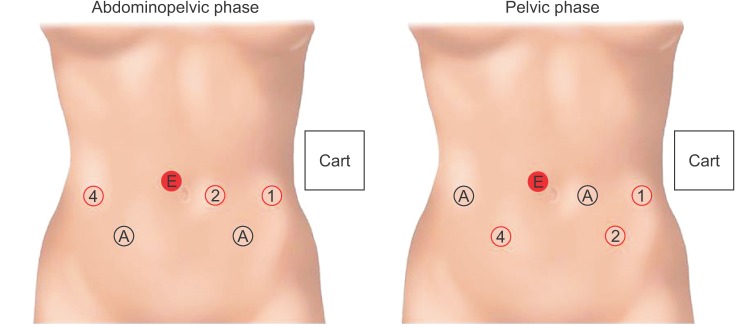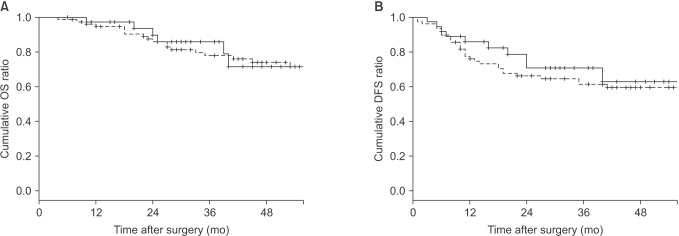Ann Surg Treat Res.
2018 Jul;95(1):37-44. 10.4174/astr.2018.95.1.37.
Comparative analysis of robot-assisted vs. open abdominoperineal resection in terms of operative and initial oncological outcomes
- Affiliations
-
- 1Department of Surgery, Asan Medical Center, Institute of Innovative Cancer Research, University of Ulsan College of Medicine, Seoul, Korea. jckim@amc.seoul.kr
- KMID: 2414451
- DOI: http://doi.org/10.4174/astr.2018.95.1.37
Abstract
- PURPOSE
The present study aimed to objectively evaluate robot-assisted abdominoperineal resection (APR) in comparison with open APR, in terms of operative elements and initial oncological outcomes.
METHODS
A total of 118 patients with lower rectal adenocarcinoma who had undergone curative APR were consecutively enrolled between June 2010 and June 2016, i.e., robot-assisted group (n = 40) and open group (n = 78).
RESULTS
Transabdominal extralevator muscle excision was more frequently performed in the robot-assisted group than in the open group (68% vs. 42%, P = 0.012). In the robot-assisted group, the pain score at one day after surgery was less than in the open group, and the resumption of bowel function was earlier (P = 0.043 and P = 0.002, respectively). The occurrence of circumferential resection margin involvement (CRM+) was more than 5 times greater in the open group than in the robot-assisted group, presenting a marginal significance (P = 0.057). Although important postoperative morbidity did not generally differ between the 2 groups, voiding difficulty and male sexual dysfunction appeared to be encountered more frequently in the open group than in the robot-assisted group.
CONCLUSION
The robot-assisted APR facilitated transabdominal extralevator excision and bowel recovery and demonstrated a trend towards reduced CRM+.
Keyword
Figure
Reference
-
1. Chau A, Maggiori L, Debove C, Kanso F, Hennequin C, Panis Y. Toward the end of abdominoperineal resection for rectal cancer? An 8-year experience in 189 consecutive patients with low rectal cancer. Ann Surg. 2014; 260:801–805. PMID: 25243547.
Article2. Weiser MR, Quah HM, Shia J, Guillem JG, Paty PB, Temple LK, et al. Sphincter preservation in low rectal cancer is facilitated by preoperative chemoradiation and intersphincteric dissection. Ann Surg. 2009; 249:236–242. PMID: 19212176.
Article3. How P, Shihab O, Tekkis P, Brown G, Quirke P, Heald R, et al. A systematic review of cancer related patient outcomes after anterior resection and abdominoperineal excision for rectal cancer in the total mesorectal excision era. Surg Oncol. 2011; 20:e149–e155. PMID: 21632237.
Article4. Bossema E, Stiggelbout A, Baas-Thijssen M, van de Velde C, Marijnen C. Patients' preferences for low rectal cancer surgery. Eur J Surg Oncol. 2008; 34:42–48. PMID: 17905562.
Article5. Zolciak A, Bujko K, Kepka L, Oledzki J, Rutkowski A, Nowacki MP. Abdominoperineal resection or anterior resection for rectal cancer: patient preferences before and after treatment. Colorectal Dis. 2006; 8:575–580. PMID: 16919109.
Article6. Eftaiha SM, Pai A, Sulo S, Park JJ, Prasad LM, Marecik SJ. Robot-assisted abdominoperineal resection: clinical, pathologic, and oncologic outcomes. Dis Colon Rectum. 2016; 59:607–614. PMID: 27270512.
Article7. Kim JC, Kwak JY, Yoon YS, Park IJ, Kim CW. A comparison of the technical and oncologic validity between robot-assisted and conventional open abdominoperineal resection. Int J Colorectal Dis. 2014; 29:961–969. PMID: 24913254.
Article8. Sieffert M, Ouellette J, Johnson M, Hicks T, Hellan M. Novel technique of robotic extralevator abdominoperineal resection with gracilis flap closure. Int J Med Robot. 2017; 13(3):DOI: 10.1002/rcs.1764.
Article9. Kim JC, Yang SS, Jang TY, Kwak JY, Yun MJ, Lim SB. Open versus robot-assisted sphincter-saving operations in rectal cancer patients: techniques and comparison of outcomes between groups of 100 matched patients. Int J Med Robot. 2012; 8:468–475. PMID: 22893623.
Article10. Moghadamyeghaneh Z, Phelan M, Smith BR, Stamos MJ. Outcomes of open, laparoscopic, and robotic abdominoperineal resections in patients with rectal cancer. Dis Colon Rectum. 2015; 58:1123–1129. PMID: 26544808.
Article11. Rosenblatt PL, McKinney J, Adams SR. Ergonomics in the operating room: protecting the surgeon. J Minim Invasive Gynecol. 2013; 20:744. PMID: 23969139.
Article12. Ljungqvist O, Scott M, Fearon KC. Enhanced recovery after surgery: a review. JAMA Surg. 2017; 152:292–298. PMID: 28097305.13. Park JS, Choi GS, Lim KH, Jang YS, Jun SH. S052: a comparison of robot-assisted, laparoscopic, and open surgery in the treat ment of rectal cancer. Surg Endosc. 2011; 25:240–248. PMID: 20552367.14. Kim JC, Lim SB, Yoon YS, Park IJ, Kim CW, Kim CN. Completely abdominal intersphincteric resection for lower rectal cancer: feasibility and comparison of robot-assisted and open surgery. Surg Endosc. 2014; 28:2734–2744. PMID: 24687417.
Article15. Lee SH, Lim S, Kim JH, Lee KY. Robotic versus conventional laparoscopic surgery for rectal cancer: systematic review and meta-analysis. Ann Surg Treat Res. 2015; 89:190–201. PMID: 26448918.
Article16. Kasparek MS, Hassan I, Cima RR, Larson DR, Gullerud RE, Wolff BG. Long-term quality of life and sexual and urinary function after abdominoperineal resection for distal rectal cancer. Dis Colon Rectum. 2012; 55:147–154. PMID: 22228157.
Article17. Enker WE, Havenga K, Polyak T, Thaler H, Cranor M. Abdominoperineal resection via total mesorectal excision and autonomic nerve preservation for low rectal cancer. World J Surg. 1997; 21:715–720. PMID: 9276702.
Article18. Lange MM, van de Velde CJ. Urinary and sexual dysfunction after rectal cancer treatment. Nat Rev Urol. 2011; 8:51–57. PMID: 21135876.
Article19. West NP, Anderin C, Smith KJ, Holm T, Quirke P. European Extralevator Abdomino perineal Excision Study Group. Multicentre experience with extralevator abdominoperineal excision for low rectal cancer. Br J Surg. 2010; 97:588–599. PMID: 20186891.
Article20. Butt HZ, Salem MK, Vijaynagar B, Chaudhri S, Singh B. Perineal reconstruction after extra-levator abdominoperineal excision (eLAPE): a systematic review. Int J Colorectal Dis. 2013; 28:1459–1468. PMID: 23440362.
Article21. West NP, Finan PJ, Anderin C, Lindholm J, Holm T, Quirke P. Evidence of the oncologic superiority of cylindrical abdominoperineal excision for low rectal cancer. J Clin Oncol. 2008; 26:3517–3522. PMID: 18541901.
Article22. Adam IJ, Mohamdee MO, Martin IG, Scott N, Finan PJ, Johnston D, et al. Role of circumferential margin involvement in the local recurrence of rectal cancer. Lancet. 1994; 344:707–711. PMID: 7915774.
Article23. Kennelly RP, Rogers AC, Winter DC. Abdominoperineal Excision Study Group. Multicentre study of circumferential margin positivity and outcomes following abdominoperineal excision for rectal cancer. Br J Surg. 2013; 100:160–166. PMID: 23147085.
Article24. van Leersum N, Martijnse I, den Dulk M, Kolfschoten N, Le Cessie S, van de Velde C, et al. Differences in circumferential resection margin involvement after abdomino perineal excision and low anterior resection no longer significant. Ann Surg. 2014; 259:1150–1155. PMID: 24096756.25. Rickles AS, Dietz DW, Chang GJ, Wexner SD, Berho ME, Remzi FH, et al. High rate of positive circumferential resection margins following rectal cancer surgery: a call to action. Ann Surg. 2015; 262:891–898. PMID: 26473651.
- Full Text Links
- Actions
-
Cited
- CITED
-
- Close
- Share
- Similar articles
-
- A comparative study of the pathological outcomes of robot-assisted versus open surgery for rectal cancer
- Robot-assisted radical cystectomy: Where we are in 2023
- Single-port robot-assisted abdominoperineal resection: a case review of the first four experiences
- Robot-Assisted Colorectal Surgery
- Radical Prostatectomy: Respective Roles and Comparisons of Robotic and Open Surgeries



